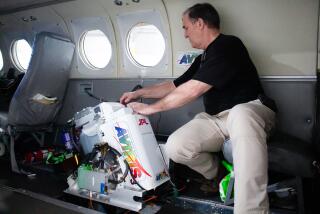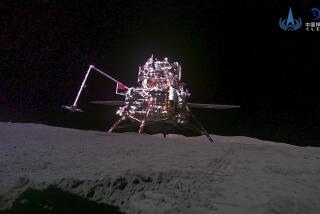Jet Propulsion Lab ushers in new year with moon-mapping project
At the Jet Propulsion Laboratory in La CaĂąada Flintridge, the New Yearâs celebration will have to wait â until 2:05 p.m. Sunday, to be exact.
Thatâs when the second of two NASA spacecraft is expected to enter the moonâs orbit on a $496-million mission scientists hope will provide unprecedented insight into the interior composition of Earthâs closest neighbor.
On Saturday afternoon, the first satellite constituting the Gravity Recovery and Interior Laboratory successfully entered the moonâs orbit after a 3 1/2-month trip from Earth.
The solar-powered GRAIL twins, each about the size of a washing machine, are expected to map the moonâs gravitational field. The data will allow scientists to deduce the moonâs structure down to its core and shed light on how Earth and the solar systemâs other rocky planets developed.
âFive billion years ago, the Earth was formed, and all the other terrestrial planets were formed, and the moon was formed,â said David Lehman, GRAIL project manager at JPL. âBut since that time, the Earth evolved â thereâs earthquakes, thereâs erosion, thereâs lots of rain. And so when we study the Earth now, we really donât have a good feeling for what happened because it changed so much.â
The GRAIL satellites will log some 12 million miles orbiting the moon over the three-month data collection phase, moving in tandem and separated by an average of 124 miles.
As they pass 34 miles above, mountains, craters and below-ground masses will cause changes in gravity that will slightly alter the velocity of the satellites and the distance between them.
Those measurements will be beamed back to Earth, where theyâll be combined with existing data to produce a precise gravitational map of the moon â information that will vastly increase our knowledge of a neighbor thatâs often taken for granted.
More than 100 scientific missions have targeted the moon since 1959. The Apollo program landed 12 people on its surface.
âYou might think given all these observations that we know all there is to know about the moon. But that is not the case,â said geophysicist Maria Zuber, the missionâs principal science investigator. âWe actually know more about Mars 100 million miles away than we do our own moon.... GRAIL is a journey to the inside of the moon.â
Both GRAIL spacecraft launched aboard a rocket from Cape Canaveral, Fla., on Sept. 10. After separating, the solar-powered twins took the long route to the moon: 2.5 million miles, about 30 times the distance traveled by Apollo astronauts.
The extra time allowed the missionâs single measurement tool â an ultra-stable oscillator â to be powered continuously and reach the proper temperature before reaching the moonâs orbit.
On Saturday the GRAIL-A satellite neared the moon at about 750 mph. At 1:21 p.m. its rockets fired, and over the next 40 minutes the craftâs velocity decreased by more than half, placing it into a stable orbit around the moon.
Its twin is expected to arrive later Sunday.
âLike all good twins, GRAIL-B will do exactly the same thing,â Lehman said. âThey arrive about 25 hours apart, which we believe is just enough time to get some breathing room between these important milestones.â
More to Read
Sign up for Essential California
The most important California stories and recommendations in your inbox every morning.
You may occasionally receive promotional content from the Los Angeles Times.










